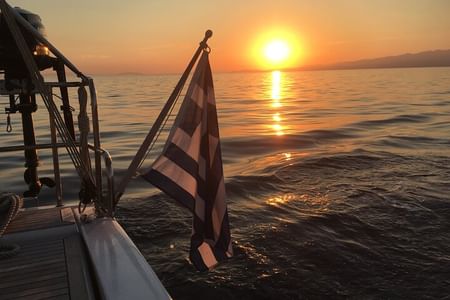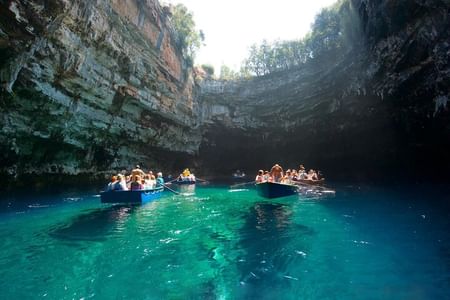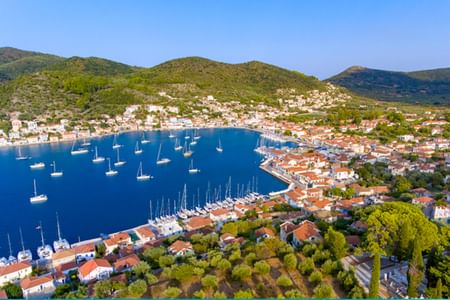Discover the world of the ancient Greek deities! The Peloponnese is a remarkable destination for experiencing Greece. Immerse yourself in myths and legends that will enchant you, set against a backdrop you're bound to adore…
10 Days Private Tour: Peloponnese
About This Tour
Inclusions
- Professional Drivers with Deep knowledge of history. [Not licensed to accompany you in any site.]
- Hotel pickup and drop-off
- Transport by private vehicle
- Bottled water
- REQUIRED FOR ENTRANCE TO ALL SITES: Passport & Vaccine Certificate/ Negative PCR 72hrs
Exclusions
- Accommodation (We work with some of the best hotels. We have to know the number of the rooms)
- Entrance Fees
- Airport Pick Up and drop-off (Additional cost)
- Licensed Tour guide on request (Additional cost)
Tour Plan
Itinerary
On the first day we will visit some of the most famous sites of eastern Peloponnese.
The tour starts with a drive along the coast, on the way you will view some Greek seaside villages and the island of Salamis (where the historical naval battle took place between the Athenians and the Persians). Our first stop the Corinth Canal. Opened in 1892 and separating the Peloponnese peninsula from the rest of Greece and connecting the Saronic Gulf to the Corinthian Sea. You will have time to walk across on a pedestrian bridge to admire the canal closer.
Moving on we will continue to Ancient Corinth. The city dominated by the hill of Acrocorinth. The site located at the foot of the hill includes the Roman Agora of Corinth, the temple of god Apollo and a small museum. Apart from its archaeological and historical interest Ancient Corinth is also one of the most popular religious destinations in Greece as this was where the Apostle Paul preached Christianity, was judged by the tribunal in the Agora and established the best organized Christian church of that period.
We will visit the castle of Acrocorinth,the oldest and largest castle in southern Greece, for some amazing photos.
Nemea is mainly known for the Nemean Games, its ancient Greek stadium and the Temple Of Zeus but it is also famous for its vineyards. Nemea has the most wineries in Greece as grape growing has been a tradition here since ancient times. Back at the site apart from the museum and the sanctuary, the stadium makes the difference. Nemea has one of the best preserved stadiums found so far and it is located on a higher level. Of special intrest are the tunnels through which the athletes entered the stadium.
Dated to the 2nd millennium B.C.E. representing what Homer wrote about, Achilles, Agamemnon and Helen of Troy. The palace of Mycenae gave its name to a whole era.
In the site you will see the famous Lions Gate (the oldest architectural sculpture in Europe), the cyclopean walls, the burial circle A and the remains of Agamemnon’s Palace.
Worth visiting there is also a modern museum exhibiting the findings of the “City Of Gold".
Just before leaving the site we will make a small stop at the treasury of Atreus, the best preserved Tholos tomb found and one of the finest examples of the Mycenaean architecture.
We will move towards a more recent history of Greece and the city of Nafplion. Considered as the most scenic city, Nafplion functioned as the capital of Greece until 1834.
Tiryns is a Mycenaean archaeological site in Peloponnese, and the location, from which mythical hero Heracles performed his 12 labors protected by UNESCO along with Mycenae.
Our next stop will be the site of Epidaurus. After just a short drive you will be able to visit one of the most important ancient sanctuaries dedicated to the God Asclepius, the god of healing and medicine, located in an ideal environment and spread over a hilly area.
The highest point of Epidaurus is the theater of Epidaurus. The best preserved ancient Greek theater dated 4th century B.C.E.It is proof of what fantastic miracles the ancient Greek minds could create. You can test the acoustics, great even today. Climb up until the upper seats just to close your eyes and dream you attended an ancient Greek tragedy.
This day you will discover the history of Laconia combining Ancient Greek and (the lesser known) Medieval Greek history.
After Nafplio we will head towards Mystras driving into the southern Peloponnese peninsula through the mountainous landscape of the Greek country side. Reaching Mystras you will automatically understand why this location stands so unique within the Greek sites. Known as the ghost city, fortified on a citadel, Mystras is one of the two locations in Greece that preserves not only medieval churches but also ordinary houses, mansions and palaces of the Byzantine Empire in combination with Frankish elements.
Walking in the site on the upper point you will reach the citadel and enjoy a magnificent view of the surrounding areas while walking down hill you will meet palaces and the Royal courtyards. Although known as the ghost city most of the monasteries are still in use and the monks will gladly show you around their small society. Before you exit you will come across the chapel of St. Demetrios, on its floor survives a plaque depicting a two head eagle (the symbol of Byzantium). It was on this very plaque that Konstantine Palaiologos kneeled before he was crowned the last emperor of the Byzantium.
Following that we will spend the rest of our time in Sparta known as the eternal rival city of the Athenian Democracy. Sparta revolved around a different Cosmo theory for the ancient Greek standards. Initially known as the birth place of Helen of Troy and the Kingdom of Menelaus (in Mycenaean period), Sparta was organized as a purely military society in the ancient Greek period. It was the city of the two Kings were a few aristocrats ruled and of course the city where Leonidas and his 300 Spartans marched from to face the Persian army Thermopolis in 480 BCE.
Continuing we will pass in front of the stadium where the statue of King Leonidas stands marking the ending point of Spartathlon race (Athens – Sparta 245,3 km).
We will visit the museum of (olive and) olive oil.
Monemvasia is a living old city, developed on an island that is connected to the Greek mainland. A fortress and a prosperous city of the Byzantine empire Monemvasia (literally means one entrance) still survives, the narrow streets, the mansions, the small houses, the churches , the wall, the gate and the citadel, the city is still inhabited. Here history comes truly alive, we will spend half of our day at Monemvasia where you can have lunch by the sea upon the old wall and walk in the city continually discovering new points of interest.
Agia Sofia (St Sophia's Church), the main sanctuary in Monemvasia's upper town, is a large Byzantine church built on the edge of a cliff with a vertiginous view of the bay below. Beyond the Venetian loggia that makes up the façade, the interior is palpably calm and refreshing. Admire the impressive dome, finely sculpted marble capitals and fragments of 13th century frescoes.
This day you will see a less known part of Greece in Mani area.
Areopoli is a town on the Mani Peninsula, Laconia, Greece.
The word Areopoli, which means "city of Ares", the ancient Greek god of war, became the official name in 1912. It was the seat of Oitylo municipality. The Greek War of Independence was started at Areopoli on March 17, 1821 by Petros Pierrakos, also known as Petros Mavromichalis, the last bey of Mani. Now Areopoli has grown into a flourishing town. Its tower houses, constructed with field stones, are distinct from the traditional blue and white buildings that characterize many Greek villages.
The cave of Diros, is found 10 km from Gytheio and 5 km from the Pyrgos Dirou. Actually there are three caves, the Alepotrypa, Katafigi and Glyfada. This is a unique experience traveling barely a subterranean river length 1,600 m. The magic of the color, and the beautiful shapes, formed by the stalactites and stalagmites makes a unique spectacle. After the ongoing research at the cave of Diros to date, the total length reaches 6.500 meters and is still unknown the final length.
Stoupa is a newly built little village at the south of Peloponnese. The picturesque sandy beaches, the small rivers, the caves, the beautiful harbors and the hill with the castle are some of the reasons more and more tourists visit every year this magical place.
The name of the village was originally “Potamos” which means river in Greek and is related with the river of the area. The name finally changed to “Stoupa”, a word coherent with sails, because of the sails the locals put into water in order to make them softer.
Kardamili is a wonderful, picturesque, historic, coastal village of Messiniaki Mani which is situated 35km southeastern to the city of Kalamata. There, the visitor can admire overgrown mountain sides, olive groves, wonderful beaches, well cared stone mansions of traditional architecture of Mani, verdant gardens and the lovely, picturesque small port.
Kalamata is the second most populous city of the Peloponnese peninsula, after Patras, in southern Greece and the largest city of the homonymous administrative region. The capital and chief port of the Messenia regional unit, it lies along the Nedon River at the head of the Messenian Gulf.
Kalamata is renowned as the land of the Kalamatianos dance and Kalamata olives.
Today you will visit the birthplace of the Olympic Games and the best preserved archaeological site of Peloponnese Peninsula.
The remains of this vast ancient city are as extensive as those of Olympia and Epidavros, yet Ancient Messini receives only a fraction of their visitors. Picturesquely situated on a hillside below the village of Mavromati and still undergoing excavation, the site comprises a large theatre, an agora (marketplace), a sizeable Sanctuary of Asclepius and one of the most impressive Ancient Greek stadiums. The entry includes the small museum at the site turn-off; don't miss the impressive Arcadian Gate 800m beyond, either.
We will visit the archaeological site and the museum of Ancient Olympia. This is one of the largest sites in Greece, the birthplace of the Olympic Games and the Sanctuary of Olympian Zeus. Walking through the site you will pass by the Gymnasium, the Palaistra, the workshop of Phidias, the Temple of Zeus and you will end up at the Stadium where for every four years the Greeks competed for glory and for spiritual elevation honoring their cities.
The museum is also quite unique as it includes the renowned statue “Hermes of Praxiteles” with its perfect analogies and tools that belonged to Phidias himself. With the tools he created one of the seven wonders of the world “the gold ivory statue of Zeus”.
The Museum of the History of the Ancient Olympic Games hosts 463 ancient works, from the Temple of Zeus at Olympia, and other museums in the Greek territory. The exhibits cover a wide chronological range, from the second millennium BC until the 5th century AD. Ancient exposed in thematic units and through them shows the history of the Olympic games, the longest ancient institution. Apart from ancient art, the visitor has the possibility of detailed information through the rich visual material.
After a walking in the footsteps of ancient athletes we will take our lunch at the village.
After we leave behind Ancient Olympia we will cross the Rio Antirio Bridge that connects Peloponnese to the mainland.
Nafpaktos is a large seaside town on the north shore of the Corinthian Gulf with a long beach and an impressive Venetian castle that includes a small fortified harbor. It was an important Athenian naval base during the Peloponnesian War due to its proximity to the western entrance of the gulf. When the Venetians took control they called it Lepanto.
Through the stunning mountainous landscapes of Fokida one reaches a town with a feel of posh, tradition, and naval history: the picturesque pride and joy of the southern coasts of central Greece, i.e. Galaxidi. Brave seamen used to sail around the Mediterranean Sea to seek refuge in the two natural ports of the little town, Agora and Chirolakas. The naval and the folklore museums bear witness to the history of Galaxidi. Here we will pass our night.
Delphi is a town on Mount Parnassus in the south of mainland Greece. It's the site of the 4th-century-B.C. Temple of Apollo, once home to a legendary oracle.
Meanwhile, at the site you will visit the temple of Apollo where Pythia spoke to the oracles.
While in the museum you will be able to see the famous charioteer and Gold Ivory statues.
Aráchova is a mountainous village nestling picturesquely at the foot of Mt. Parnassós in Viotia, Southern Greece. It is the most cosmopolitan winter destination in Greece, a great favorite for passionate ski lovers and celebrities, or just first-time visitors who wish to relax in a dreamy mountainous setting with modern tourism facilities. Its modern ski resort, its close proximity to Athens, and its breathtaking mountainous landscape are the strongest reason why. Apart from the mountain activities, Aráchova is also famous for its bustling nightlife and as the favorite mountain resort of Athenians.
First, we will drive to Thermopylae. It was here that 10 years after the Battle of Marathon, King Leonidas and his 300 brave Spartans heroically faced the Persian army. In the historical center, an enjoyable a 3D movie will be shown.
As if traveling through time you will feel the presence of heroes who stood their ground for their freedom against a foreign conqueror. To conclude you will visit the statue of Leonidas standing exactly opposite Kolonos Hill where the persistent Spartans left their last breath.
Walk around the Thermopylae Battlefield.
We will stop at the coastal village of Kammena Vourla, where we will enjoy a relaxing, traditional Greek lunch by the sea. And to terminate the tour we will drive back to Athens safe and sound.
We will drive back to Athens.
Meeting / Pickup
Know Before You Go
- Wheelchair accessible
- Stroller / pram accessible
- Infant seats available
Please Note
- Not suitable for pets
- No public transportation nearby
- Infants must not sit on laps
- Wheelchair accessible
- Not wheelchair accessible
- Accommodation (If you need our help we work with some of the best hotels in each area, we only need to know the number of the rooms)
- The duration of the tours is approximate, the exact duration will depend on the time of day and traffic conditions
- The drivers are not licensed to accompany you inside any site or museum. If you require a licensed guide to tour the sites with you, you need to hire one additionally. If you have any questions you can contact us on the phone number provided by Viator.
- Our company complies with all the health instructions of the World Health Organization about COVID-19.
- Our contact Email: [ ] - Don't hesitate to ask any more questions you may have.
- Pick up time adjustable upon your request.
Reviews
Save 11%
🎁 First Time Booking-
Limited Time Offer: All Dates, All Destinations






























